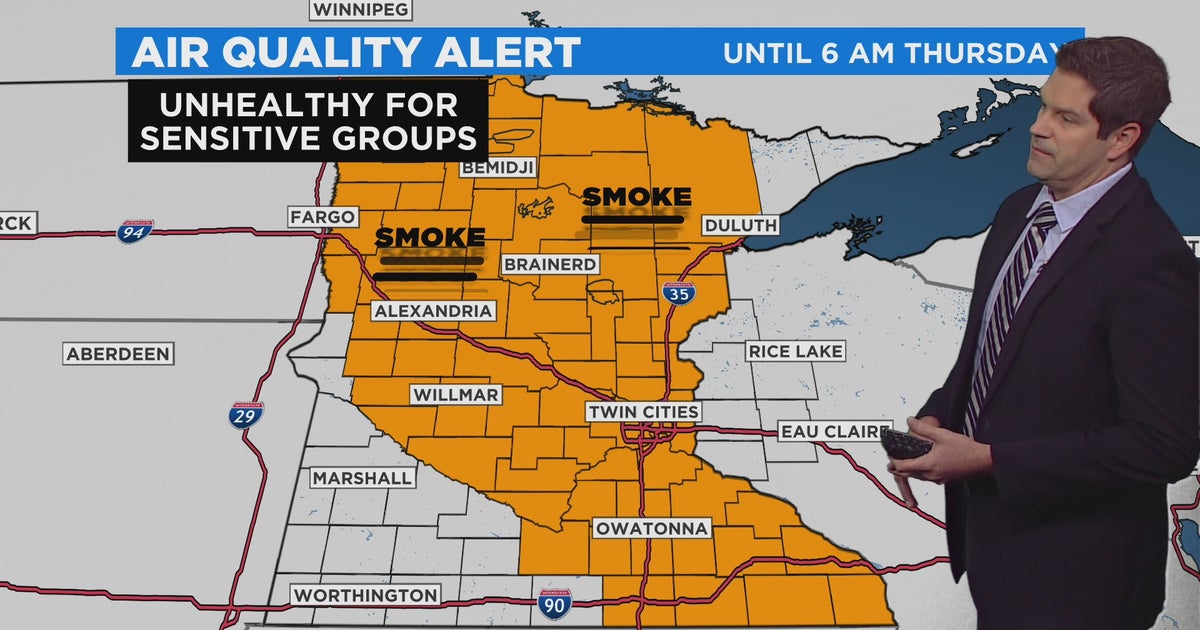Degraded Air Quality In Minnesota Due To Canadian Wildfires

Table of Contents
The Impact of Canadian Wildfires on Minnesota's Air Quality
The smoke plumes from the extensive Canadian wildfires are significantly impacting Minnesota's air quality, creating a serious public health concern. This degradation is not a localized issue; it highlights the far-reaching consequences of these devastating events.
Pollutant Transportation and Dispersion
Wildfire smoke, a complex mixture of pollutants, travels vast distances, impacting air quality far from the source. Prevailing westerly wind patterns are the primary mechanism transporting smoke from Canada to Minnesota. The distance the smoke travels and its concentration in Minnesota depend on several factors.
- Prevailing wind patterns: Westerly winds, common in Minnesota, efficiently carry smoke plumes south and east from Canadian wildfire zones.
- Atmospheric conditions influencing smoke transport: Atmospheric stability, temperature inversions, and precipitation all influence the dispersion and concentration of smoke. Inversions, for instance, can trap smoke near the ground, increasing its concentration.
- Specific examples of smoke plumes reaching Minnesota: Recent satellite imagery and air quality monitoring data have clearly shown several instances of significant smoke plumes originating from Canadian wildfires directly impacting Minnesota.
- Use of air quality models to track smoke movement: Sophisticated air quality models, such as those used by the Minnesota Pollution Control Agency (MPCA), predict smoke transport and dispersion, allowing for timely warnings and public health advisories.
Health Concerns from Degraded Air Quality
Exposure to wildfire smoke poses significant health risks, especially for vulnerable populations. The fine particulate matter (PM2.5) in smoke is particularly harmful, penetrating deep into the lungs and bloodstream.
- Respiratory illnesses (asthma, bronchitis): Wildfire smoke exacerbates respiratory conditions like asthma and bronchitis, leading to increased hospitalizations and emergency room visits.
- Cardiovascular issues: Exposure to PM2.5 has been linked to increased cardiovascular problems, including heart attacks and strokes.
- Eye and throat irritation: Smoke can cause eye irritation, coughing, and throat discomfort.
- Increased hospitalizations and emergency room visits: Data from Minnesota hospitals shows a noticeable increase in respiratory-related illnesses during periods of high smoke concentration.
Air Quality Index (AQI) and Monitoring
The Air Quality Index (AQI) is a number used by government agencies to communicate how clean or polluted the air is. The MPCA provides real-time AQI data for various locations across Minnesota.
- Interpretation of AQI values: Higher AQI values (above 100) indicate unhealthy air quality, with different levels representing increasing health risks. The MPCA website provides detailed explanations of each AQI level and their associated health impacts.
- Locations of air quality monitoring stations in Minnesota: The MPCA maintains a network of monitoring stations across the state, providing comprehensive coverage.
- How to access real-time AQI data online: Real-time AQI data and forecasts are readily available on the MPCA website and through various mobile applications.
- Use of apps and tools for monitoring air quality: Several mobile apps provide real-time AQI updates, allowing Minnesotans to stay informed about air quality in their specific area.
Mitigation Strategies and Protective Measures
Protecting yourself and your family from the harmful effects of degraded air quality is crucial. Both individual actions and governmental responses are critical in mitigating the risks.
Individual Actions to Reduce Exposure
Minnesotans can take proactive steps to minimize their exposure to wildfire smoke:
- Staying indoors with air purifiers: Staying indoors, especially in air-conditioned spaces equipped with HEPA air purifiers, significantly reduces exposure.
- Using air conditioning: Air conditioning helps filter out some pollutants and keeps indoor air cooler and less prone to the buildup of smoke.
- Wearing an N95 mask when going outdoors: An N95 mask provides better protection against PM2.5 than other types of masks.
- Minimizing strenuous outdoor activities: Reduce or avoid strenuous outdoor activities during periods of high AQI, as increased breathing can lead to higher smoke inhalation.
- Monitoring personal health: Pay attention to any respiratory symptoms and seek medical attention if necessary.
Governmental and Community Responses
Government agencies and communities are taking steps to address the air quality crisis:
- Public health advisories and warnings: The MPCA and other health agencies issue advisories and warnings based on AQI levels, providing guidance to the public.
- Emergency response plans: Emergency response plans are being activated to address the increased demand for healthcare services.
- Community outreach and education programs: Educational campaigns are informing the public about the risks of wildfire smoke and protective measures.
- Collaboration with Canadian authorities: Collaboration between Minnesota and Canadian authorities is crucial for information sharing and coordinated responses.
Long-Term Implications and Future Preparedness
The increasing frequency and intensity of wildfires pose a significant long-term challenge to Minnesota's air quality.
Climate Change and Wildfire Risk
Climate change is a key driver of increased wildfire risk:
- Rising temperatures and drought conditions: Warmer temperatures and drier conditions create ideal conditions for wildfires to ignite and spread rapidly.
- Impacts on forest ecosystems: Climate change alters forest ecosystems, increasing the risk of large-scale wildfires.
- Long-term projections of wildfire risk: Climate models predict a significant increase in wildfire risk in the coming decades.
Strategies for Future Air Quality Management
Addressing the long-term implications requires proactive measures:
- Investing in air quality monitoring infrastructure: Expanding the network of monitoring stations and improving data analysis capabilities is essential.
- Developing comprehensive emergency response plans: Well-defined plans are needed to effectively manage public health emergencies caused by degraded air quality.
- Promoting sustainable forest management practices: Sustainable forest management can reduce the risk of large-scale wildfires.
- Public awareness campaigns on air quality: Ongoing public education is crucial to empower individuals and communities to protect their health.
Conclusion
The degraded air quality in Minnesota, a direct consequence of the Canadian wildfires, presents a serious public health challenge. Understanding the impacts of wildfire smoke, monitoring the AQI, and taking protective measures are crucial for safeguarding Minnesotans' health. By implementing long-term strategies for air quality management and addressing the root causes of increased wildfire risk, we can better prepare for future events and protect our communities from the devastating effects of degraded air quality due to Canadian wildfires. Stay informed about Minnesota's air quality, and take the necessary precautions to protect yourself and your family. Learn more about the current AQI and protective measures at [link to MPCA website or other relevant resource].

Featured Posts
-
 The Good Life Practical Steps For A More Fulfilling Life
May 31, 2025
The Good Life Practical Steps For A More Fulfilling Life
May 31, 2025 -
 Two Weeks Free Accommodation German Citys Incentive For New Residents
May 31, 2025
Two Weeks Free Accommodation German Citys Incentive For New Residents
May 31, 2025 -
 Rachat D Un Anticorps Par Sanofi Partenariat Avec Dren Bio
May 31, 2025
Rachat D Un Anticorps Par Sanofi Partenariat Avec Dren Bio
May 31, 2025 -
 Foire Au Jambon 2025 Deficit Et Explosion Des Couts La Ville De Bayonne Seule Responsable
May 31, 2025
Foire Au Jambon 2025 Deficit Et Explosion Des Couts La Ville De Bayonne Seule Responsable
May 31, 2025 -
 Elon Musks Return From Dogecoin To Business Empire
May 31, 2025
Elon Musks Return From Dogecoin To Business Empire
May 31, 2025
